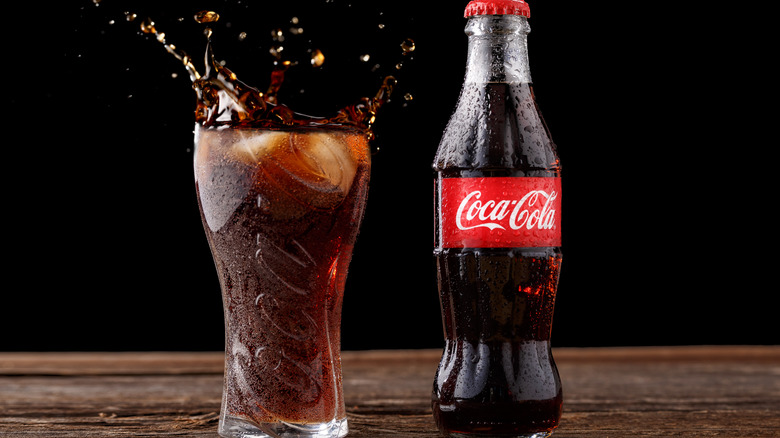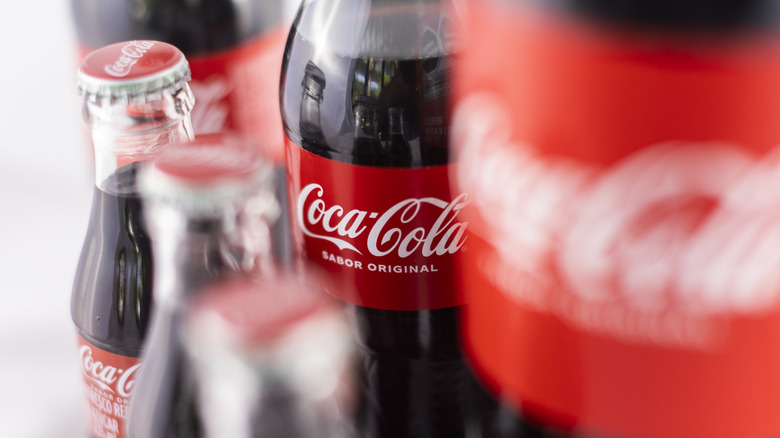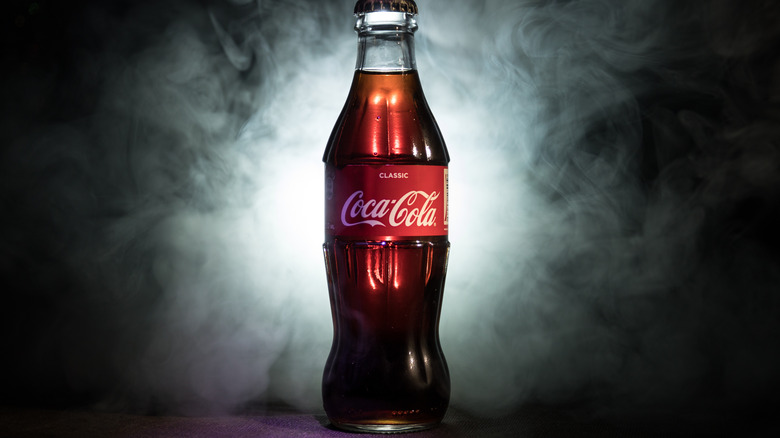The Inspiration Behind The Shape Of Coca-Cola's Iconic Original Bottle
Coca-Cola is an American original, born in 1886 in Atlanta, Georgia, where its parent company still operates its headquarters to this very day (via Coca-Cola Company). Initially sold at pharmacy-adjacent soda fountains, Coca-Cola quickly evolved into a global brand, and one of the most recognized and beloved ones at that. In the century-plus since the first sale of the soda, Coca-Cola has put a pep in the step of millions of people billions of times with its secret blend of flavorings, spices, sweeteners, and caffeine.
The remarkable taste and wild success of Coca-Cola would give rise to a worldwide carbonated cola movement, of which Coke would remain the industry standard and leader. No other soft drink tastes or packs a punch the way a Coke does, nor do they boast that familiar red packaging with the beverage's name in white script. That drink used to come in glass bottles, designed and executed with distinctive originality as singular as every other element of Coke. Here's the story of that well-known Coca-Cola bottle.
Coke bottles weren't always so recognizable
John S. Pemberton created Coca-Cola in 1886, but it didn't really take off in sales until after Pemberton died two years after perfecting his invention and businessman Asa Griggs Candler bought the company. In the aftermath of the company founder's death, Candler quickly launched a multi-tiered marketing plan to boost Coke's fortunes. In fact, according to Wired, Candler was so keen on selling the product that he tasked sales reps with a rather remarkable advertising strategy.
In order to make sure that customers knew the taste of the revolutionary drink, Candler instructed his salesmen to distribute coupons for a free serving at a soda fountain. It didn't take long to prove that this strategy was a success. According to the Coca-Cola Company, bottling of the much-sought-after drink began in 1894 and swiftly ramped up, growing from just two facilities into a network of more than 1,000 within 20 years' time.
Coca-Cola, available prepackaged and in bottles, made for a much more convenient option than obtaining a glass full of the stuff from a soda fountain inside of a pharmacy. By making Coke shippable, exportable, and more readily drinkable to millions, Candler widely increased the company's profitability. In essence, the product spoke for itself, but its packaging was another matter. Per Coca-Cola, the soft drink came bottled in a succession of unremarkable, flat-sided glass containers — just like the ones Coke's competitors used.
The wrong plant inspired the Coke bottle
Coca-Cola was a unique product, but it was originally sold in decidedly un-unique glass bottles, similar to those used by the makers of Coke knockoff soft drinks. Of course, it doesn't take a marketing genius to realize that the problem with this tactic is that unremarkable labeling doesn't stand out to customers. As a result, executives at Coca-Cola headquarters sought a way to improve their business and the recognizability of their product.
According to the Coca-Cola Company, the soft drink maker put the call out to its bottling contractors — to create a singular bottle design, recognizable not just by look, but by feel (if, say, a customer was fishing through an icebox looking for a drink to grab). In 1916, the Root Glass Company devised a curvy bottle prototype, resembling and inspired by the shape of a cocoa bean. That's the result of a misunderstanding — the glass maker got cocoa mixed up with coca, an ingredient once present in Coca-Cola's formula.
Coca, also the source of cocaine, was removed from Coca-Cola around 1900, according to the New York Times. But the "contour bottle" design remained a part of the product's branding for decades. The company even patented its design in 1977, and you're very unlikely to mix this design up with that of another drink even to this day.


